In these Microorganisms Friend and Foe notes, students will learn about the basics of Microorganisms and how they can be helpful and harmful to us. Microorganisms, tiny living organisms invisible to the naked eye, profoundly impact our lives. They are found everywhere, from the depths of the ocean to the highest mountains and even within our own bodies. In the study of microorganisms, it becomes evident that they can be both friends and foes to humans and the environment.
Microorganisms are incredibly diverse, encompassing various types such as bacteria, viruses, fungi, protozoa, and algae. Each type has its own characteristics and capabilities. Understanding their roles and effects is essential for appreciating their importance in our daily lives.
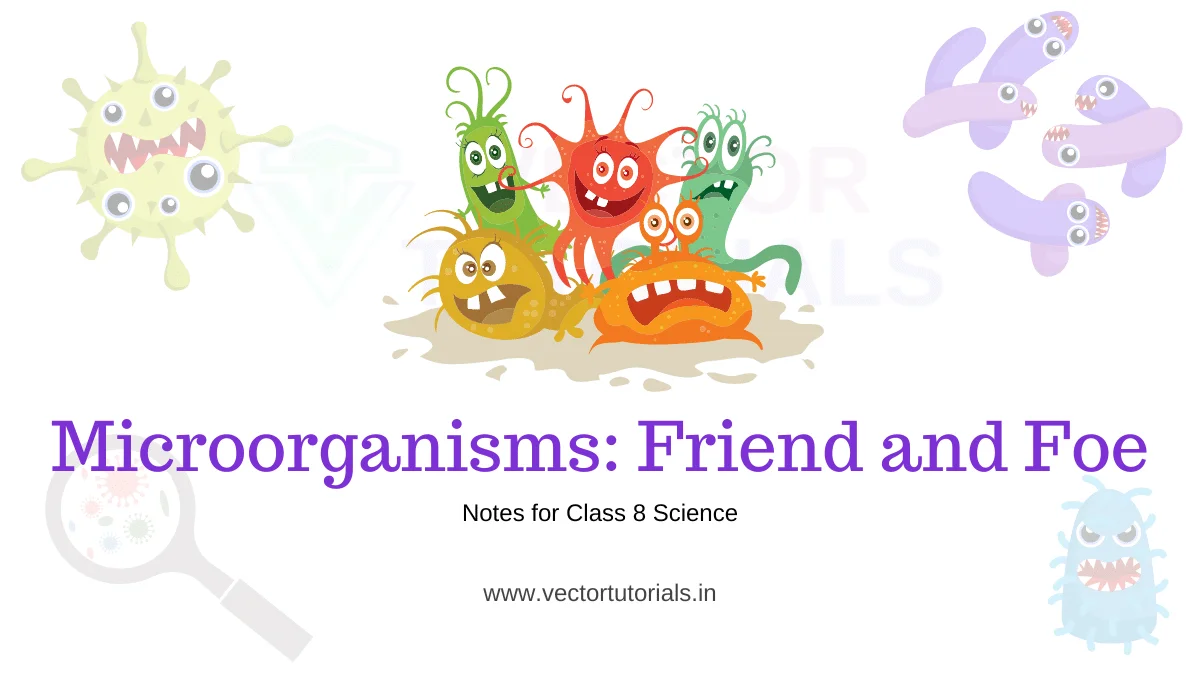
Microorganisms Friend and Foe Notes
Understanding the balance between the beneficial and harmful aspects of microorganisms is crucial. By studying their characteristics, life cycles, and interactions, we can develop strategies to harness their positive contributions while mitigating the negative impacts. That’s what these Microorganisms Friend and Foe notes cover.
By gaining knowledge about microorganisms’ notes, we can appreciate their significance in our lives and make informed decisions to maximize their benefits while minimizing their harms.
Microorganisms
- Organisms that are too small to be seen with our naked eyes are called microorganisms or microbes.
- They can only be seen using a microscope.
- Microorganisms are found in a variety of habitats, such as air, soil, and water.
- They can live and survive in extreme environments, from ice-cold regions to hot springs, from deserts to marshy lands.
- Some microorganisms are useful to us in many ways. They are called beneficial microbes. Example: Bacterium Rhizobium helps in nitrogen fixation.
- Some microorganisms cause diseases in plants, animals, and human beings. They are called pathogens. Example: Anthrax bacillus causes anthrax in animals.
- Robert Hooke and Anton Van Leeuwenhoek discovered the existence of microbes during the period 1665 – 1683.
Major Groups of Microorganisms
1. Algae
- They are found on walls, in fields, and in small puddles.
- It may be unicellular or multicellular with a size of 1 µ-1 m.
- Oscillatoria, Nostoc, and Anabaena are examples of this type of algae.
- Sexual reproduction occurs by conjugation.
2. Fungi
- Grows on stale bread, chapati, pickles, damp clothes, and shoes in monsoon.
- Respires aerobically or anaerobically.
- Lives a saprophytic or parasitic life.
- Mucor, Rhizopus, and Aspergillus are examples of fungi.
3. Protozoa
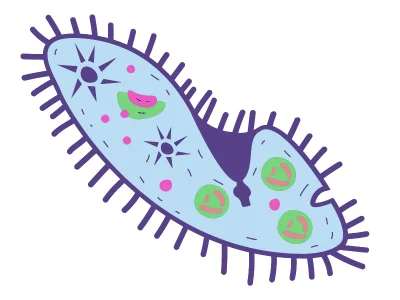
- Amoeba, Paramecium, and Plasmodium are examples of protozoa.
- Amoeba has an irregular shape. Its locomotion occurs through pseudopodia.
- Paramecium is slipper-shaped. It has numerous cilia for locomotion.
- Plasmodium is a protozoan living a parasitic life. It is responsible for the spread of malaria.
4. Bacteria
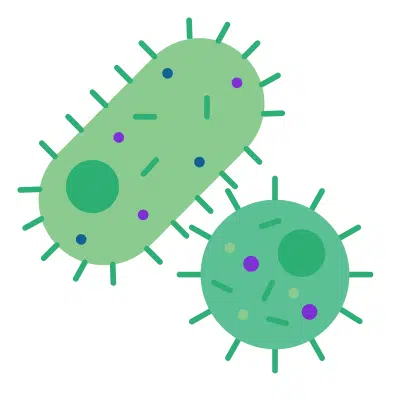
- Found in any kind of environment from deserts to Polar Regions.
- The range in size is from 0.2 to 10 µ.
- Reproduces sexually and asexually.
- Respires aerobically or anaerobically.
- The main types of bacteria according to their shape are Coccus, Bacillus, Vibrio, and Spirillium.
- Rhizobium and Lactobacillus are examples of bacteria.
5. Virus
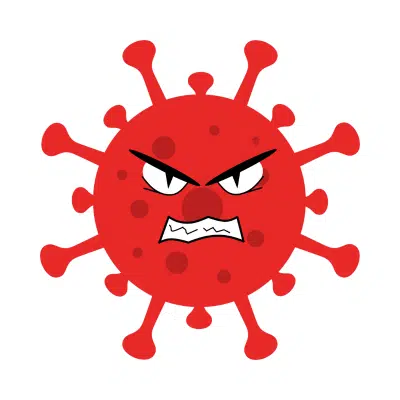
- The smallest microorganisms can grow and develop only inside the host cell.
- In free-living form, viruses are like non-living particles.
- Viruses are classified into three types based on the type of host they infect.
- Examples:
- Animal viruses: Foot and Mouth Disease Virus (FMDV)
- Plant viruses: Tobacco Mosaic Virus (TMV)
- Bacteriophage: Coliphage infecting Escherichia coli
Necessary Conditions for the Growth of Microorganisms
- Suitable medium
- Supply of oxygen
- Suitable temperature
- Availability of food
- Availability of moisture
- Availability of sunlight
Useful Microorganisms
- Increasing soil fertility: Some bacteria and fungi act as decomposers and decompose dead and decaying matter and help in recycling nutrients back to the soil.
- Cleaning the environment: Microorganisms decompose complex organic matter such as waste of vegetables, fruits, plants and animals, and convert them into simpler substances, thereby cleaning the environment.
- Retting of fibres: Some bacteria carry out the process of loosening of fibres of plants by rotting, also called retting.
- Tanning of leather: During tanning, bacteria attack the skin of animals. The protein structure of the skin undergoes a permanent alteration. This makes them soft and pliable and the skin is converted into leather.
- Food Industry:
- Yeast helps in the commercial production of beer, wine and other alcoholic drinks by fermenting fruit juices, malted grains or molasses.
- Yeast is often used in the baking industry for making breads, pastries and cakes.
- Bacteria find application in the making of curd.
- Algae are a rich source of wholesome and nutritious food.
- Production of Antibiotics: Antibiotics are manufactured by growing specific microorganisms to treat a wide variety of diseases caused by pathogenic microorganisms.
- The first antibiotic penicillin was discovered by Alexander Fleming in 1929. Fungus Penicillium notatum produces penicillin.
- Production of Vaccines: Vaccines are made on a large scale from microorganisms to protect human beings and other animals from several diseases.
- TAB Vaccines: For Typhoid
- BCG Vaccine: For Tuberculosis
- Triple Vaccine: For Diphtheria, Whooping cough, and Tetanus.
- Polio Vaccine: For Poliomyelitis.
Harmful Microorganisms
- Pathogens can successfully cause disease due to the following factors:
- a. Ability to multiply fast.
- b. Ability to destroy tissues of the body of otherorganisms.
- c. Ability to produce toxins which affect certain organs of the host.
- Communicable Diseases: Microbial diseases which can spread from an infected person to a healthy person through air, water, food, physical contact or through vectors are called communicable diseases. Examples: Tuberculosis, chickenpox.
- The insects or other animals which transmit disease causing microorganisms to humans without themselves getting infected are called carriers. Examples: Housefly, mosquito.
Some of the Common Human Diseases Caused by Microorganisms
| Disease | Causative microorganism | Mode of transmission | Preventive measures |
| Measles | Virus | Air | Dirty, humid or overcrowded habitats should be avoided. Vaccination should be given at the appropriate age. |
| Chickenpox | Virus | Air/Contact | |
| Polio | Virus | Air/Water | |
| Tuberculosis | Bacteria | Air | |
| Hepatitis A | Virus | Water | Drink boiled drinking water. |
| Typhoid | Bacteria | Water | Personal hygiene, cleanliness of the surroundings and consumption of well-cooked, nutritious food. Vaccination should be given at the appropriate age. |
| Cholera | Bacteria | Water/Food | |
| Amoebiasis | Protozoa | Water/Food/Flies | |
| Malaria | Protozoa | Mosquito bite | Population of mosquitoes should be reduced or eliminated. |
Common Animal Diseases caused by Microorganisms
| Disease | Animal affected | Causative microorganism |
| Anthrax | Cattle, sheep, elephant | Bacteria |
| Diphtheria | Guinea pigs, kittens, rabbits | Bacteria |
| Dysentery | Monkeys | Bacteria |
| Plague | Rats, squirrels, rabbits, guinea pigs | Bacteria |
| Tuberculosis | Monkeys, dogs, parrot, cattle | Bacteria |
| Lung necrosis | Adult cattle | Fungi |
| Foot and mouth disease | Split hoofed animals | Virus |
| Swine flu | Pigs | Virus |
Some Common Plant Diseases Caused by Microorganisms
| Disease | Plant affected | Causative microorganism |
| Angular leaf spot | Cotton | Bacteria |
| Blight Canker | Paddy | Bacteria |
| Rust | Wheat | Fungi |
| Smut | Barley, wheat, oats, sugarcane, forage grasses | Fungi |
| Ergot | Corn, rye, wheat, bajra, barley | Fungi |
| Tikka disease | Groundnut | Fungi |
| Blast | Rice, ragi | Fungi |
| Late blight disease | Potato, tomato, black pepper, vanilla | Fungi |
| Sheath blight disease | Paddy | Fungi |
| Ring spot disease | Sugarcane | Fungi |
| Red rot disease | Sugarcane | Fungi |
| Yellow vein mosaic disease | Okra | Virus |
Prevention of Communicable Diseases
- Mouth and nose should be covered with a handkerchief while sneezing or coughing.
- Uncovered roadside food should not be consumed
- Food should be kept covered to protect it from getting infected by flies
- We should protect ourselves from mosquito bites using mosquito repellents or mosquito nets
- Consume boiled water
- Avoid sharing towels and combs
- There should not be open garbage dump or stagnant water in the locality.
Food Poisoning
Spoilage of food by the action of microorganisms is called food poisoning. It mostly occurs due to consumption of food spoilt by fungi and bacteria. When these organisms come in contact with food, they decompose it and release chemical toxins. This contaminates or spoils food.
Food Preservation
Food preservation is the process of treating and handling food in order to stop or slow down its spoilage while maintaining its nutritional value, texture and flavor.
Advantages of Food Preservation
- It reduces the wastage of food
- Preservation helps us to transport food to distant places
- Preservation of food helps to store food for use in season when they are not available.
Principles of Food Preservation
- Keeping out the food from the reach of microorganisms
- Removing microorganisms
- Inhibiting the growth of microorganisms
- Killing of microorganisms
Methods of food preservation
- Boiling: Boiling the water kills all bacteria present in the water. Higher temperature of about 110 degree kill spores.
- Salting: With salting biodegradation is prevented under normal conditions.
- Preservation by sugar: It reduces the moisture content which inhibits the growth of bacteria.
- Dehydration: It inhibits the growth of microbes.
- Irradiation: Radioactive or ultraviolet radiation kills the microorganisms
- Pasteurization: It involves heating to a temperature of about 60 C for 30 min and then chilling kills bacteria.
- Refrigeration: Storing food in the refrigerators inhibits the growth and multiplication of microbes.
- Chemical Preservatives: Sodium benzoate increases the concentration of solutes causing plasmolysis and death of bacteria and mould.
Nitrogen Fixation
The process of converting nitrogen gas of the atmosphere into compounds of nitrogen which can be used by plants is called nitrogen fixation.
- By nitrogen-fixing bacteria: Ammonia is converted to nitrates by nitrifying bacteria.
- By Rhizobium bacteria: Rhizobia live in the root nodules of leguminous plants. They convert free nitrogen from the atmosphere into soluble nitrates.
- By blue-green algae: They fix nitrogen gas into ammonia, nitrates and nitrites.
- By lightening: During lightning, nitrogen and oxygen from the atmosphere combine to form nitrogen oxides which react with rainwater and form dilute nitric acid. Nitric acid reacts with the minerals present in the soil and forms nitrate.
Nitrogen Cycle
- The process of circulation of nitrogen between the atmosphere, soil, plants and animals is called the nitrogen cycle.
- Atmospheric nitrogen is fixed by biological nitrogen fixers as well as through physical processes such as lightning.
1. Nitrogen Fixation during Lightning
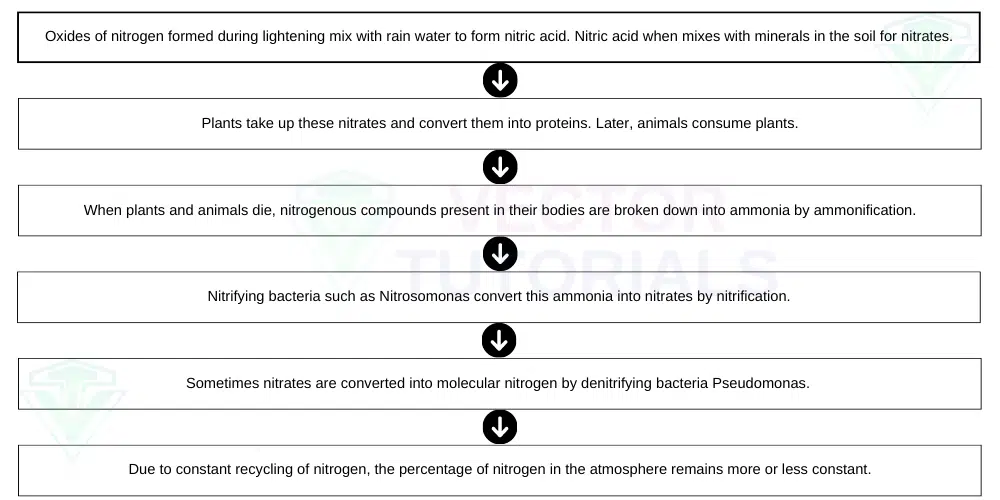
2. Biological Nitrogen Fixation
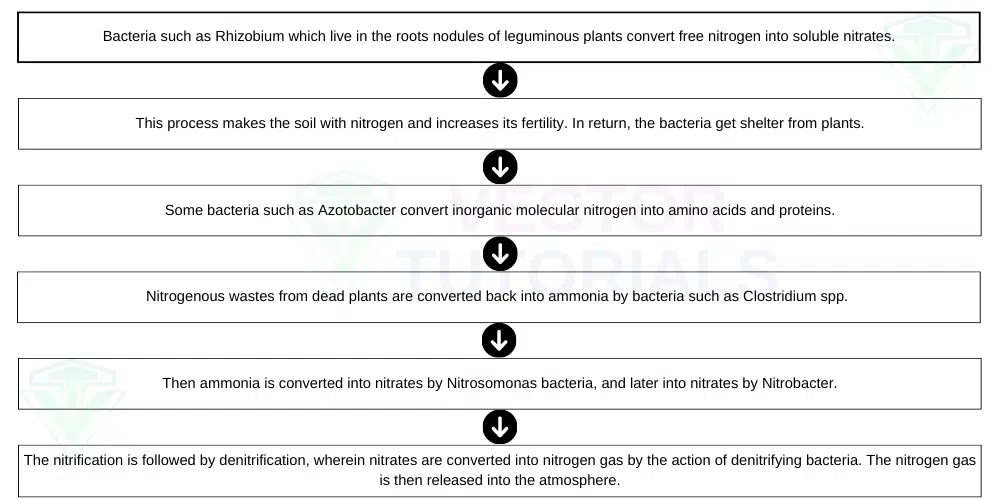
FAQs for Microorganisms Friend and Foe
So far we have learnt about Microorganisms Friend and Foe and understood how they can be helpful and harmful for us. Microorganisms are involved in various beneficial applications. In the field of medicine, scientists have harnessed the power of microorganisms to produce life-saving antibiotics, revolutionizing the treatment of bacterial infections. They are also utilized in the production of vaccines, helping protect us from numerous diseases. In the food industry, microorganisms are used in fermentation processes, leading to the creation of delicious products like bread, yogurt, and cheese.
However, microorganisms can also be foes. Certain bacteria, viruses, and fungi have the ability to cause diseases in humans, animals, and plants. They can lead to illnesses ranging from the common cold and flu to more severe conditions like tuberculosis and malaria. Recent COVID-19 pandemic is one such example.
More notes for Class 8 Science: